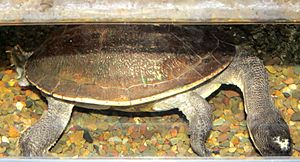New Guinea snake-necked turtle facts for kids
Quick facts for kids New Guinea snake-necked turtle |
|
|---|---|
 |
|
| Conservation status | |
| Scientific classification | |
| Genus: |
Chelodina
|
| Species: |
novaeguineae
|
 |
|
| Synonyms | |
|
|
The New Guinea snake-necked turtle (Chelodina novaeguineae) is a cool type of turtle. It belongs to a group of turtles called Chelidae. You can find this special turtle mostly in the Western Province of Papua New Guinea.
Contents
Where New Guinea Turtles Live
This turtle loves to live in water! You can find C. novaeguineae in both small and large freshwater areas. It enjoys jungle rivers that have lots of plants growing in them. These plants provide good hiding spots and food.
What New Guinea Turtles Look Like
The New Guinea snake-necked turtle has a dark brown shell on its back. This top shell is called a carapace. It can look almost black. The bottom shell, called the plastron, is a lighter brown or tan color.
One of the most amazing things about this turtle is its super long neck. Its neck, including its head, can sometimes be even longer than its body shell! The turtle's skin is mostly gray. However, its head is black, and its belly is white.
How New Guinea Turtles Behave
When this turtle wants to rest, it doesn't pull its head straight back into its shell. Instead, it twists its long neck to the side. This helps keep its head safe from danger.
Its flexible neck is also great for finding food. The turtle can use its neck to search for snacks in the mud. It can even use its neck like a snorkel to breathe while staying hidden underwater. This long neck also helps the turtle strike very quickly to catch its prey.
Reproduction and Life Cycle
The New Guinea snake-necked turtle lays eggs. This means it is an oviparous animal. Female turtles lay between 17 and 21 eggs at a time. The eggs then need to stay warm to hatch. This warming period is called incubation. It usually takes about 75 to 110 days for the eggs to hatch. The exact time depends on how warm the temperature is around the eggs.


